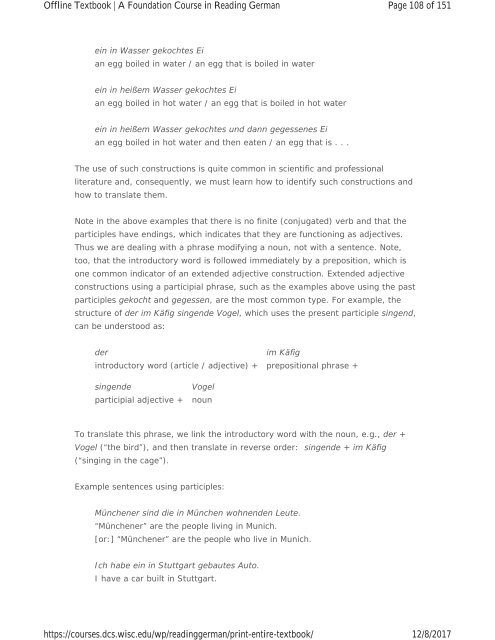A Foundation Course in Reading German, 2017a
A Foundation Course in Reading German, 2017a
A Foundation Course in Reading German, 2017a
You also want an ePaper? Increase the reach of your titles
YUMPU automatically turns print PDFs into web optimized ePapers that Google loves.
Offl<strong>in</strong>e Textbook | A <strong>Foundation</strong> <strong>Course</strong> <strong>in</strong> Read<strong>in</strong>g <strong>German</strong><br />
https://courses.dcs.wisc.edu/wp/read<strong>in</strong>ggerman/pr<strong>in</strong>t-entire-textbook/<br />
Page 108 of 151<br />
12/8/2017<br />
e<strong>in</strong> <strong>in</strong> Wasser gekochtes Ei<br />
an egg boiled <strong>in</strong> water / an egg that is boiled <strong>in</strong> water<br />
e<strong>in</strong> <strong>in</strong> heißem Wasser gekochtes Ei<br />
an egg boiled <strong>in</strong> hot water / an egg that is boiled <strong>in</strong> hot water<br />
e<strong>in</strong> <strong>in</strong> heißem Wasser gekochtes und dann gegessenes Ei<br />
an egg boiled <strong>in</strong> hot water and then eaten / an egg that is . . .<br />
The use of such constructions is quite common <strong>in</strong> scientific and professional<br />
literature and, consequently, we must learn how to identify such constructions and<br />
how to translate them.<br />
Note <strong>in</strong> the above examples that there is no f<strong>in</strong>ite (conjugated) verb and that the<br />
participles have end<strong>in</strong>gs, which <strong>in</strong>dicates that they are function<strong>in</strong>g as adjectives.<br />
Thus we are deal<strong>in</strong>g with a phrase modify<strong>in</strong>g a noun, not with a sentence. Note,<br />
too, that the <strong>in</strong>troductory word is followed immediately by a preposition, which is<br />
one common <strong>in</strong>dicator of an extended adjective construction. Extended adjective<br />
constructions us<strong>in</strong>g a participial phrase, such as the examples above us<strong>in</strong>g the past<br />
participles gekocht and gegessen, are the most common type. For example, the<br />
structure of der im Käfig s<strong>in</strong>gende Vogel, which uses the present participle s<strong>in</strong>gend,<br />
can be understood as:<br />
der<br />
<strong>in</strong>troductory word (article / adjective) +<br />
im Käfig<br />
prepositional phrase +<br />
s<strong>in</strong>gende<br />
participial adjective +<br />
Vogel<br />
noun<br />
To translate this phrase, we l<strong>in</strong>k the <strong>in</strong>troductory word with the noun, e.g., der +<br />
Vogel (“the bird”), and then translate <strong>in</strong> reverse order: s<strong>in</strong>gende + im Käfig<br />
(“s<strong>in</strong>g<strong>in</strong>g <strong>in</strong> the cage”).<br />
Example sentences us<strong>in</strong>g participles:<br />
Münchener s<strong>in</strong>d die <strong>in</strong> München wohnenden Leute.<br />
“Münchener” are the people liv<strong>in</strong>g <strong>in</strong> Munich.<br />
[or:] “Münchener” are the people who live <strong>in</strong> Munich.<br />
Ich habe e<strong>in</strong> <strong>in</strong> Stuttgart gebautes Auto.<br />
I have a car built <strong>in</strong> Stuttgart.


















